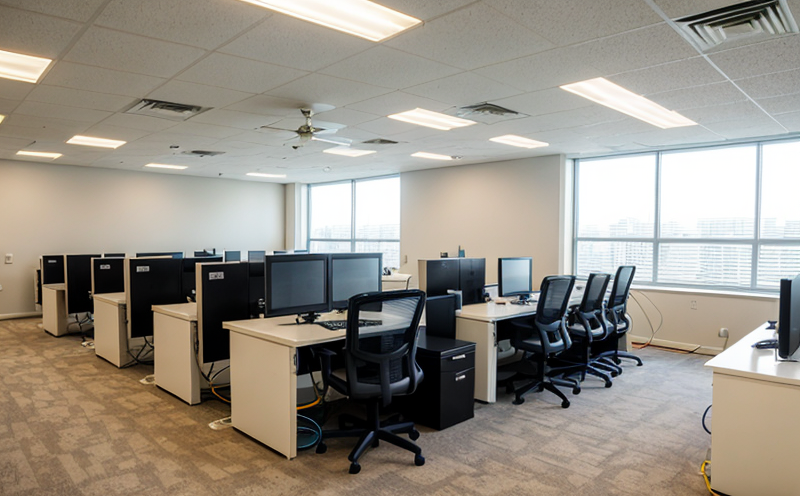IEC 62301 Standby Power Consumption Testing of Lighting Products
The International Electrotechnical Commission (IEC) Standard IEC 62301 focuses on the standby power consumption testing of lighting products. This standard is crucial for ensuring that modern lighting devices do not consume excessive electricity during their low-power standby mode, which can lead to unnecessary energy waste and increased utility costs.
Standby power refers to the electrical power consumed by a device when it is switched off but still connected to the mains supply. Lighting products such as LED lamps, ballasts, and other similar devices often have standby modes that allow them to remain operational for quick startup or in case of interruption. However, these low-power states can contribute significantly to overall energy consumption if not managed properly.
The IEC 62301 standard provides a comprehensive framework for measuring the standby power consumption of lighting products. It specifies test procedures that help manufacturers and regulatory bodies ensure compliance with efficiency targets set by various countries and regions around the world. By adhering to this standard, manufacturers can demonstrate their commitment to sustainability while also meeting legal requirements.
The testing process involves connecting a representative sample of each product type to specialized equipment designed to measure power consumption accurately under specified conditions. These tests are conducted in controlled environments that mimic real-world usage scenarios as closely as possible. The results from these tests play a vital role in certifying the energy efficiency of lighting products.
One key aspect of IEC 62301 is its emphasis on minimizing standby power losses through various design improvements and technological advancements. For instance, modern LED drivers are optimized to reduce power draw during idle periods without sacrificing performance or reliability. Similarly, improved thermal management solutions help maintain optimal operating temperatures even when the system is not fully active.
Another important consideration in IEC 62301 testing is understanding how different factors such as ambient temperature, humidity levels, and voltage fluctuations affect standby power consumption. Manufacturers must account for these variables during design phases to ensure consistent performance across diverse operating conditions. Additionally, the standard encourages continuous improvement by promoting best practices that can further reduce standby losses.
Compliance with IEC 62301 not only enhances product quality but also contributes positively towards global efforts aimed at reducing carbon footprints and conserving natural resources. As part of broader sustainability initiatives, many organizations are adopting stringent energy efficiency policies that prioritize the use of compliant products in their supply chains.
By undergoing rigorous IEC 62301 testing, manufacturers gain valuable insights into potential areas for improvement within their designs. This knowledge empowers them to make informed decisions about future product development and innovation cycles. Ultimately, adherence to this standard helps foster a more efficient lighting industry that benefits both consumers and the environment alike.
Benefits
Compliance with IEC 62301 offers numerous advantages for manufacturers seeking to enhance their product offerings while meeting stringent regulatory requirements. One major benefit is improved market access, as many jurisdictions mandate adherence to this standard when importing or selling lighting products within their borders. This ensures that imported goods meet local standards and expectations.
Another advantage lies in enhanced brand reputation, where successful compliance demonstrates a company’s dedication to responsible business practices and environmental stewardship. Such initiatives resonate well with environmentally conscious consumers who increasingly favor sustainable brands over less eco-friendly alternatives.
In terms of operational efficiency, IEC 62301 helps identify opportunities for reducing manufacturing costs by optimizing power consumption during non-operational states. By minimizing unnecessary energy usage, businesses can lower their overall operating expenses while simultaneously contributing to cost savings for end-users.
Furthermore, compliance fosters innovation by encouraging manufacturers to explore new technologies and approaches aimed at achieving optimal performance with minimal resource utilization. This proactive approach promotes the development of more advanced solutions that address current challenges faced in lighting technology.
Customer Impact and Satisfaction
The implementation of IEC 62301 has a direct positive impact on customer satisfaction by delivering products that are both efficient and reliable. When customers know they are purchasing environmentally friendly lighting solutions, they feel confident about their choices, which enhances overall brand loyalty.
Additionally, reduced standby power consumption translates into lower electricity bills for consumers, providing them with tangible financial benefits. This aligns well with broader sustainability goals, encouraging more widespread adoption of energy-efficient technologies across various sectors.
In summary, IEC 62301 plays a crucial role in enhancing customer satisfaction by delivering high-quality products that are not only functional but also contribute to long-term environmental sustainability. By prioritizing these aspects during product development and manufacturing processes, companies can build strong relationships with their customers while promoting responsible business practices.
International Acceptance and Recognition
The International Electrotechnical Commission (IEC) standard IEC 62301 is widely recognized across many countries for its stringent requirements regarding standby power consumption in lighting products. This global acceptance underscores the importance of energy efficiency standards worldwide.
Many nations have incorporated aspects of this standard into their national regulations, ensuring that imported and locally manufactured lighting devices meet strict energy performance criteria. For instance, the United States has adopted similar guidelines through its Energy Star program, which promotes energy-efficient products based on rigorous testing protocols aligned with IEC 62301.
Similarly, countries like China have implemented policies requiring compliance with specific sections of this standard to ensure that imported goods meet stringent environmental standards. Such measures reflect a global commitment to reducing carbon footprints and conserving natural resources.
The widespread adoption of IEC 62301 also fosters international trade by creating harmonized standards across borders, making it easier for manufacturers to export their products globally without encountering barriers due to differing regulatory requirements. This harmonization streamlines the certification process, reducing costs and time spent on adapting products for specific markets.
Moreover, adherence to this standard enhances a company’s reputation on an international scale by demonstrating its commitment to sustainability initiatives. Many multinational corporations prioritize suppliers who demonstrate consistent compliance with globally recognized standards like IEC 62301, further emphasizing the importance of this practice in today's competitive market environment.





